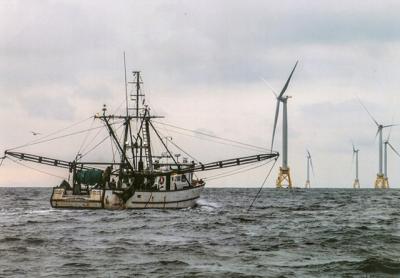Deepwater Now Exploring New Cable Route

In response to strong opposition from commercial fishermen who fear a disruption of their work and destruction of fish habitat, officials of Deepwater Wind, a Rhode Island company that plans to construct a 15-turbine wind farm approximately 30 miles off Montauk, are exploring an alternative to an initial plan to route the installation’s transmission cable through Gardiner’s Bay.
At an April meeting of the East Hampton Town Trustees, several fishermen voiced those concerns to Clint Plummer, Deepwater Wind’s vice president of development, should the transmission cable be laid to make landfall in Gardiner’s Bay.
On July 6, the East Hampton Town Board authorized a license agreement with Deepwater Wind allowing it to conduct soil sampling and habitat delineations at a town-owned right of way at Napeague Lane in Amagansett.
Mr. Plummer said yesterday that Deepwater Wind’s exploration of a southern route for the proposed South Fork Wind Farm’s transmission cable underscores the company’s effort to solicit feedback from all stakeholders and respond accordingly. “We have taken that guidance very seriously, as we are investigating some potential routes on the south shore,” he said. “We’re working through where this could go. There are a lot of technical and environmental data we’re gathering. In the next few months, we will be able to go public with alternative routes.”
Mr. Plummer has emphasized that the development phase of an offshore wind farm is much longer than its construction phase, which he has estimated would be a few months. A rigorous review by federal, state, and local regulatory agencies will require some 20 approvals, he said, as was the case for the Block Island Wind Farm, which Deepwater developed over approximately eight years. That installation, the nation’s first offshore wind farm, went online in December.
“Developing a project of this scale is a long process, and we are at the very beginning,” he said. “Most people are surprised to learn how many approvals are required, and how in-depth that process is.” The company is on track to submit permit applications in the first quarter of 2018, he said. Previous estimates had the South Fork Wind Farm operational in late 2022.
The trustees’ harbor management committee has met monthly, Rick Drew, a deputy clerk of the trustees, told his colleagues at their meeting on July 10, with the South Fork Wind Farm a primary topic of its meetings. The next meeting, he said, will happen on Aug. 16 at 6 p.m. at the trustees’ office in the Donald Lamb Building in Amagansett. It is to focus on the project’s environmental impact, particularly with the laying of the transmission cable and the installation of the turbines’ bases on the ocean floor. “It’s an interesting opportunity for us to learn more about the project, and we are looking to have more representation from the commercial and recreational fishing community at this meeting,” he said.
Mr. Drew said that he has informed Deepwater Wind officials that a “well-presented executive summary of all this research,” including comment from all stakeholders, is planned. He estimated an early fall presentation of that summary. “We’re really challenging them to deliver a quality proposal,” he said of Deepwater Wind.
Diane McNally of the trustees had asked Mr. Drew, at the July 10 meeting, for information on the Block Island Wind Farm’s operation. Mr. Plummer said yesterday that the installation is meeting performance expectations. It is projected to produce approximately 125,000 megawatt hours per year, he said, and “we’re on track to meet that number over the course of the next year.”
He described feedback from residents of East Hampton, which set a goal of meeting 100 percent of its energy needs from renewable sources by 2020, as “overwhelmingly positive” to date. “We talk with folks who are very excited that East Hampton is leading the way to becoming one of the first 100-percent renewable energy communities in the country, and to learn how offshore wind becomes a part of that renewable energy solution.”
